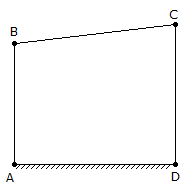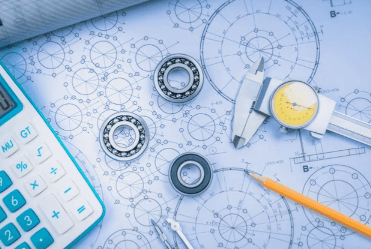Question

a.
v
b.
2v/3
c.
3v/2
d.
9v/4
Posted under Mechanical Engineering
Interact with the Community - Share Your Thoughts
Uncertain About the Answer? Seek Clarification Here.
Understand the Explanation? Include it Here.
Q. ABCD is a four bar mechanism in which AB = 310 mm and CD = 450 mm. AB and CD are both perpendicular to the fixed link AD, as shown in the below figure. If the velocity of B at this...
Similar Questions
Explore Relevant Multiple Choice Questions (MCQs)
Q. In a differential band brake as shown in the below figure, if the length OB is greater than OA, then the force P at C should act in the downward direction.
View solution
Q. In the below figure, PC is the connecting rod and OC is the crank making an angle θ with the line of stroke PO and rotates with uniform angular velocity at ω rad/s. The Klien's acceleration diagram for determining the acceleration of the piston P is shown by quadrilateral C Q NO. The acceleration of the piston P with respect to the crankpin C is given by
View solution
Q. In the below figure, PC is the connecting rod and OC is the crank making an angle θ with the line of stroke PO and rotates with uniform angular velocity at ω rad/s. The Klien's acceleration diagram for determining the acceleration of the piston P is shown by quadrilateral C Q NO, if N coincides with O, then
View solution
Q. For the brake to be self locking, the force P at C shown in the below figure, should
View solution
Q. In the below figure, PC is the connecting rod and OC is the crank making an angle θ with the line of stroke PO and rotates with uniform angular velocity at ω rad/s. The Klien's acceleration diagram for determining the acceleration of the piston P is shown by quadrilateral C Q NO, the acceleration of the piston is zero when the crank OC and connecting rod PC are at right angles to each other.
View solution
Q. In the two rotor system as shown in the below figure (I1 < I2), a node of vibration is situated
View solution
Q. A rotor supported at A and B carries two masses as shown in the below figure. The rotor is
View solution
Q. For a twin cylinder V-engine, the crank positions for primary reverse cranks and secondary direct cranks are shown in the below figure. The engine is a
View solution
Q. In under damped vibrating system, if x1 and x2 are the successive values of the amplitude on the same side of the mean position, then the logarithmic decrement is equal to
View solution
Q. The ratio of velocities of the shafts connected by Hooke's joint is given by (where N and N1 = Speed of driving and driven shafts (in r.p.m.) respectively, θ = Angle through which the arms of the cross turn, and α = Angle of inclination between the two shafts)
View solution
Q. A shaft of mass (mc) and stiffness (s) is fixed at one end and carries a mass (m) at the other end. The natural frequency of its longitudinal vibration is equal to
View solution
Q. Two pulleys of radii r1 and r2 and at distance x apart are connected by means of a cross belt drive. The length of the belt is
View solution
Q. A motor car moving at a certain speed takes a left turn in a curved path. If the engine rotates in the same direction as that of wheels, men due to centrifugal force
View solution
Q. The natural frequency of free transverse vibrations due to uniformly distributed load acting over a simply supported shaft is (where δS = Static deflection of simply supported shaft due to uniformly distributed load)
View solution
Q. The pitching of a ship is assumed to take place with simple harmonic motion.
View solution
Q. A pair is said to be a kinematic pair, if the relative motion between them is completely or successfully constrained.
View solution
Q. The instantaneous centres, which moves as the mechanism moves but joints are of permanent nature, are called permanent instantaneous centres.
View solution
Q. The efficiency of a screw jack is dependent upon the load raised or lowered.
View solution
Q. An overdamped system, when disturbed from the equilibrium position, will not cross the equilibrium position.
View solution
Q. A governor is said to be isochronous when range of speed is zero for all radii of rotation of the balls within the working range, neglecting friction.
View solution
Recommended Subjects
Are you eager to expand your knowledge beyond Mechanical Engineering? We've handpicked a range of related categories that you might find intriguing.
Click on the categories below to discover a wealth of MCQs and enrich your understanding of various subjects. Happy exploring!








